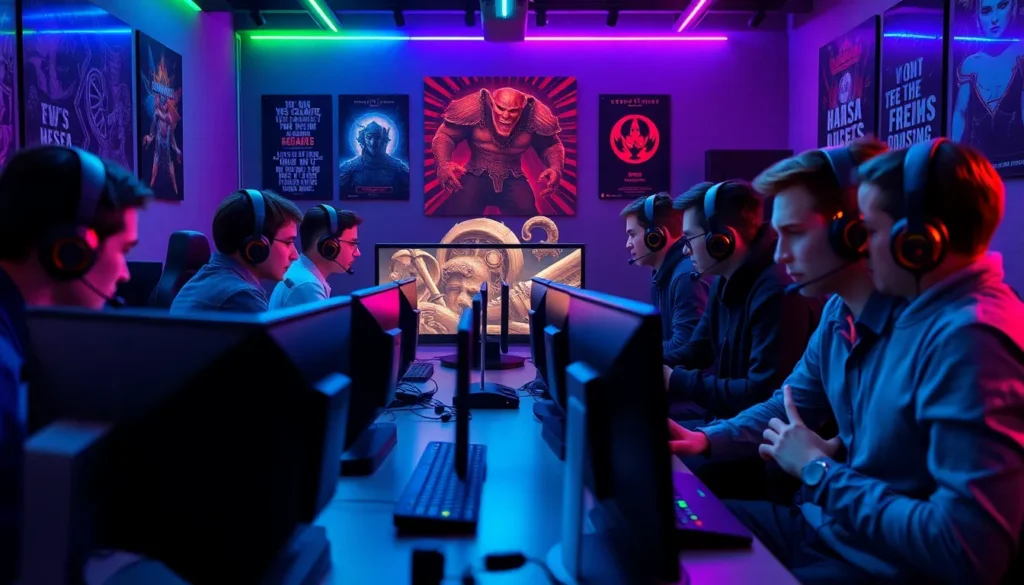In the ever-evolving world of game development, insights from experienced gamers play an invaluable role in demystifying the intricate process behind creating video games. The archives of game development ramblings offer a combination of knowledge and personal anecdotes, shedding light on various facets of this vibrant industry. This article will explore key phases in game development, the critical roles within development teams, the unique challenges faced by indie developers, and the importance of community engagement. Join us as we investigate into the world of game creation and the essential skills that foster success.
Table of Contents
ToggleOverview Of Game Development

Key Phases in Game Development
Game development is typically segmented into multiple phases to ensure organized and effective production. The primary phases include:
- Conceptualization: This initial phase involves brainstorming ideas and defining the core mechanics of the game. Developers create a high-level vision, which will guide the entire project.
- Pre-production: Here, the development team formulates a game design document (GDD) that outlines specific objectives, gameplay mechanics, and artistic direction. This phase sets the groundwork for subsequent phases.
- Production: The most labor-intensive phase, production involves creating the assets, programming, and implementing game mechanics. Developers work collaboratively to bring the project to life, iterating on designs as needed.
- Testing: This phase is crucial for identifying bugs and ensuring the game runs smoothly. Quality assurance teams play a significant role in testing gameplay elements and providing feedback to improve overall quality.
- Launch and post-launch: Once the game is complete, it is launched on various platforms, followed by ongoing support, updates, and community engagement efforts.
Importance of Game Design Document
The Game Design Document (GDD) acts as a blueprint for developers, detailing everything from gameplay mechanics to visual aesthetics. The GDD serves several purposes:
- Communication: It ensures that all team members are aligned with the game’s vision, minimizing misunderstandings and enhancing collaboration.
- Organizational Tool: A well-structured GDD helps maintain focus on objectives and timelines, making it easier to track progress during development.
- Future Reference: After the game’s launch, the GDD can be a valuable resource for sequels or spin-offs, providing insights into what worked well and what needed adjustments.
Roles and Responsibilities in Development Teams
Prototyping and Testing
Prototyping is a critical task in game development that allows teams to experiment with ideas and mechanics before full implementation. Development teams often use various prototyping techniques, such as:
- Paper Prototyping: Creating physical representations of gameplay elements to test mechanics in a low-cost, low-risk environment.
- Digital Prototyping: Using software tools to create interactive elements that represent gameplay. This approach enables teams to gather feedback more effectively.
Testing often runs parallel to prototyping, providing real-time feedback. Playtesting with target audiences helps identify flaws and areas for improvement.
The Role of Feedback in Iterative Development
Iterative development thrives on feedback, allowing for continuous refinement of game elements. This approach includes:
- User Feedback: Engaging with players during testing phases uncovers potential issues and avenues for enhancement. Developers must be open to suggestions, as players often provide perspectives that insiders may overlook.
- Team Feedback: Cross-departmental communication ensures that design, art, and programming perspectives align. Regular team meetings and brainstorming sessions create an inclusive environment where all voices matter.
Challenges Faced by Indie Developers
Funding and Budgeting in Game Development
Indie developers often grapple with funding, as limited resources can significantly impact the scope of their projects. Key considerations include:
- Crowdfunding: Platforms like Kickstarter and Indiegogo allow indie developers to present their ideas to potential backers, securing funds while simultaneously building an audience.
- Grants and Competitions: Various organizations provide financial support for innovative gaming projects, helping developers mitigate risks.
- Budgeting: Creating a realistic budget ensures that the project remains financially viable. Developers must account for costs related to personnel, software, marketing, and other essential expenses.
Marketing Strategies for Indie Games
In the fiercely competitive gaming market, indie developers must craft effective marketing strategies to stand out. Successful tactics include:
- Networking: Building relationships within the gaming community can lead to collaborations and support. Attend industry events, forums, and social media groups to expand connections.
- Content Creation: Developing engaging content, such as trailers and gameplay videos, can capture the interest of potential players. Effective storytelling through these mediums creates a narrative around the game that resonates with audiences.
Community Engagement and Building a Following
Utilizing Social Media for Promotion
In the digital age, social media platforms play a pivotal role in engaging with gaming communities. Developers can leverage various platforms for promotional purposes:
- Twitter and Instagram: Regular updates, behind-the-scenes content, and interaction with followers can strengthen community ties. Using relevant hashtags increases visibility and reach.
- YouTube and Twitch: Livestreaming development processes, hosting Q&A sessions, and showcasing gameplay can build excitement and attract a dedicated fanbase.
Creating Engaging Content for Your Audience
Engagement is not merely about promotion: it’s about creating value. Game developers can:
- Share Development Stories: Personal insights into the challenges and successes of development foster a sense of connection with audiences.
- Host Contests and Giveaways: Encouraging community participation through fun activities and rewards can create buzz and deepen loyalty to the game.
Conclusion
Game development is a complex journey, filled with creative passion and technical challenges. Exploring the archives of game development ramblings provides valuable insights into the multifaceted processes that define this industry. From understanding the key phases of development and the essential roles within teams to recognizing the unique challenges faced by indie developers and the importance of community engagement, every aspect contributes to the vibrant tapestry of game creation. As game developers leverage these insights, they can navigate the obstacles of development while shaping memorable experiences for players.





